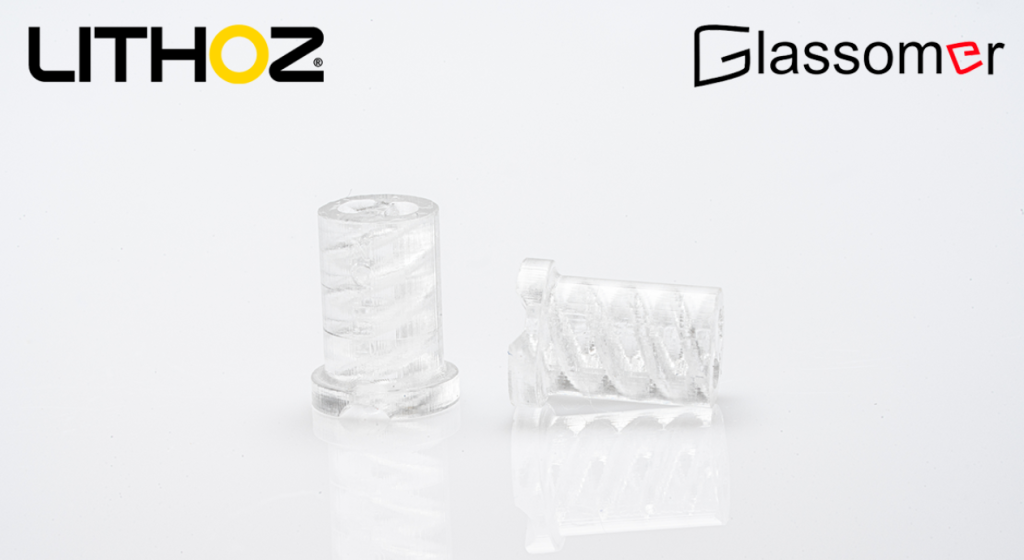Austrian ceramic 3D printing company Lithoz and Germany-based glass manufacturer Glassomer have launched a new 3D printing material called LithaGlass, a high-performance fused silica glass.
Lithoz’s Lithography-based Ceramic Manufacturing (LCM) 3D printing technology is the only method able to 3D print LithaGlass with precision and complexity. The composite slurry, which has a quartz glass base, is expected to have a significant impact in the field of ceramics and 3D printing, says Lithoz.
“Glassomer’s choice of Lithoz’s LCM process as their key technology to achieve this innovation once again proves the sheer potential and flexibility of our system. The new LithaGlass material brings our company one step closer to our vision – finding solutions to every challenge of today with a 3D printed ceramic answer,” said Dr. Johannes Homa, Lithoz CEO.

A way to drive innovation in ceramics, glass, and 3D printing
Following three new successful material releases and two technology launches in the last year, this latest invention expands Lithoz’s array of 3D printing slurries. LithaGlass is more similar to ceramic than typical glasses like soda-lime glass, and it shares material qualities with fused silica glass, such as minimal thermal expansion and strong thermal shock resistance. With the introduction of LithaGlass, both firms hope to “accelerate advancements” in ceramics, glass, and 3D printing.
According to both companies, LithaGlass is expected to have important consequences for a variety of industries, and both firms are excited to see how it will be used in the future. Dr. Frederik Kotz-Helmer, CSO of Glassomer explains, “Our transparent high-purity glass solutions offer enormous potential for many applications, especially for high-stability optical and technical parts. With Lithoz we have a powerful partner to make our glasses available for high precision 3D printing – which will significantly advance science and technology.”
Exploring LCM technology for precise and complex ceramic parts manufacturing
LCM technology is a 3D printing method that allows for the exact and detailed manufacture of ceramic parts. This technology depends on lithography principles, which entail transferring a design onto a surface utilizing a light-sensitive substance. A ceramic slurry is placed onto a build platform in the case of LCM, and a projector exposes a layer of the slurry to UV light, allowing the ceramic particles to harden and create a layer. Layer by layer, the procedure is continued until the desired shape is produced, at which point the item is sintered at high temperatures to attain its ultimate hardness and density.
LCM technology is suitable for manufacturing delicate ceramic components with complex shapes and features, better precision, and a smooth surface finish. This technology is employed in a variety of industries, including aerospace, biomedical, and electronics, where ceramic parts are needed for favorable material qualities like high-temperature resistance, chemical resistance, and biocompatibility.
Advances in ceramic 3D printing
Researchers at the University of Waterloo in Canada developed a novel technique for 3D printing household products from functionally-graded ceramics. It is possible to accurately program functionally-graded materials to have qualities that differ from one surface to the next, allowing them to meet specific applications. The Waterloo team developed a technique to adjust the deformation of a graded clay-based composite during wet processing and 3D printing. This approach allows the creation of screens that can “grade” the lighting of lamps.
Synteris, a Maryland-based startup, raised $2.7 million for the development of an innovative ceramic 3D printing technique. Synteris’ technology, dubbed Selective Laser Reaction Sintering (SLRS), is intended to be used as an alternate method of creating parts from non-oxide ceramics such as carbides, nitrides, and borides. Using this funding, which came in the form of an ARPA-E grant, the company sought to use SLRS to develop a new type of electronics packaging capable of increasing EV and aeroplane performance.
What does the future of 3D printing for the next ten years hold?
What engineering challenges will need to be tackled in the additive manufacturing sector in the coming decade?
To stay up to date with the latest 3D printing news, don’t forget to subscribe to the 3D Printing Industry newsletter or follow us on Twitter, or like our page on Facebook.
While you’re here, why not subscribe to our Youtube channel? Featuring discussion, debriefs, video shorts, and webinar replays.
Are you looking for a job in the additive manufacturing industry? Visit 3D Printing Jobs for a selection of roles in the industry.
Featured image shows Lithoz and Glassomer launch LithaGlass. Image via Lithoz.



